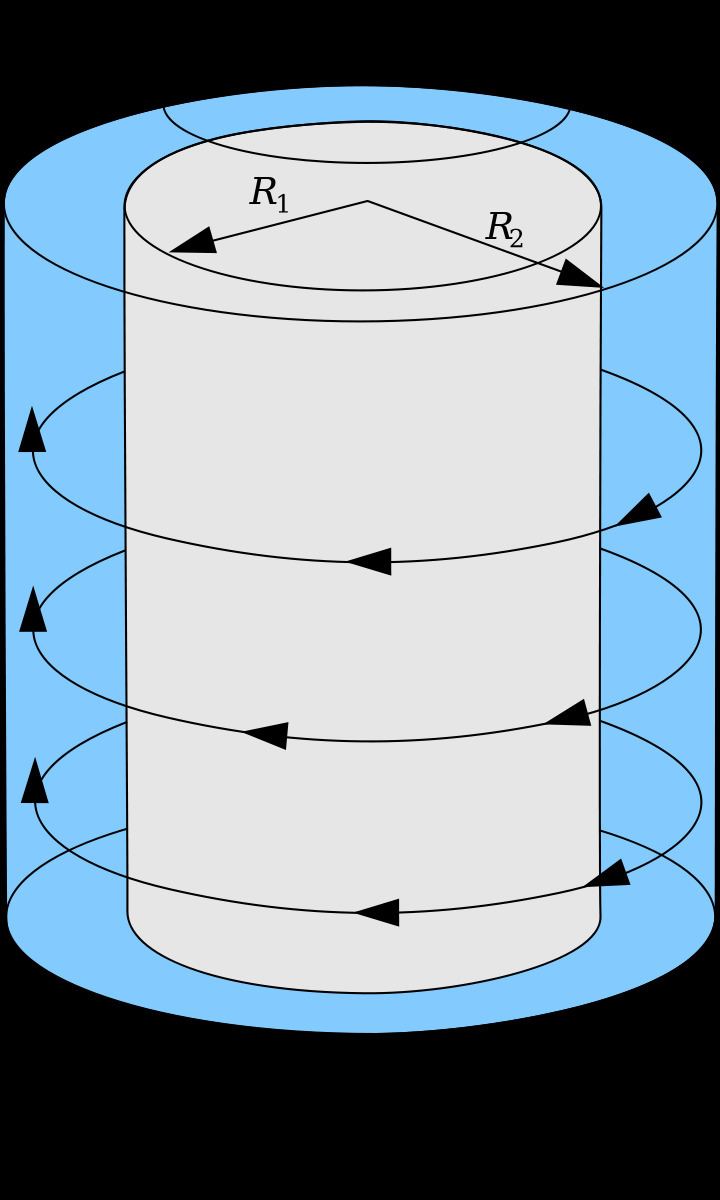 | ||
In fluid dynamics, the Taylor–Couette flow consists of a viscous fluid confined in the gap between two rotating cylinders. For low angular velocities, measured by the Reynolds number Re, the flow is steady and purely azimuthal. This basic state is known as circular Couette flow, after Maurice Marie Alfred Couette who used this experimental device as a means to measure viscosity. Sir Geoffrey Ingram Taylor investigated the stability of the Couette flow in a ground-breaking paper which has been a cornerstone in the development of hydrodynamic stability theory
Contents
Taylor showed that when the angular velocity of the inner cylinder is increased above a certain threshold, Couette flow becomes unstable and a secondary steady state characterized by axisymmetric toroidal vortices, known as Taylor vortex flow, emerges. Subsequently increasing the angular speed of the cylinder the system undergoes a progression of instabilities which lead to states with greater spatio-temporal complexity, with the next state being called as wavy vortex flow. If the two cylinders rotate in opposite sense then spiral vortex flow arises. Beyond a certain Reynolds number there is the onset of turbulence.
Circular Couette flow has wide applications ranging from desalination to magnetohydrodynamics and also in viscosimetric analysis. Furthermore, when the liquid is allowed to flow in the annular space of two rotating cylinders along with the application of a pressure gradient then a flow called Taylor–Dean flow arises. Different flow regimes have been categorized over the years including twisted Taylor vortices, wavy outflow boundaries, etc. It has been a well researched and documented flow in fluid dynamics.
Taylor vortex
Taylor vortices (also named after Sir Geoffrey Ingram Taylor) are vortices formed in rotating Taylor–Couette flow when the Taylor number (
For flow in which
instabilities in the flow are not present, i.e. perturbations to the flow are damped out by viscous forces, and the flow is steady. But, as the
Rotating Couette flow is characterized geometrically by the two parameters
and
where the subscript "1" refers to the inner cylinder and the subscript "2" refers to the outer cylinder. The idealized mathematical problem is posed by choosing a particular value of
Flow regimes
One significance of Taylor–Couette flow is due to the changes in flow regimes which eventually lead to turbulence. It is hoped that by studying these systems a more general understanding of transitions to turbulence will emerge.
Many of the flow regimes have been observed in multiple experiments and have thus acquired a standard naming convention. For instance:
as well as a number of others. "Wavy" in this sense refers to the progression of changes to the flow in the angular direction. The entire map of flow regimes is incomplete; experiments are sometimes conducted to elucidate a particular region of interest, but gaps in understanding remain. One potentially distinct regime called "soft turbulence" has been identified.
Taylor–Couette experiments may sometimes include additional system features, such as an imposed axial flow, pulsating flow, etc. designed to better understand certain transitions.
Gollub–Swinney circular Couette experiment
In 1975, J. P. Gollub and H. L. Swinney published a paper on the onset of turbulence in rotating fluid. In a Taylor–Couette flow system, they observed that, as the rotation rate increases, the fluid stratifies into a pile of "fluid donuts". With further increases in the rotation rate, the donuts oscillate and twist and finally become turbulent. Their study helped establish the Ruelle–Takens scenario in turbulence, which is an important contribution by Floris Takens and David Ruelle towards understanding how hydrodynamic systems transition from stable flow patterns into turbulent. While the principal, governing factor for this transition is the Reynolds number, there are other important influencing factors: if the flow is open (meaning there is a lateral up- and downstream), closed (flow is laterally bound; e.g. rotating), bounded (influenced by wall effects) or unbounded (not influenced by wall effects). According to this classification the Taylor–Couette flow is an example of a flow pattern forming in a closed, bounded flow system.
